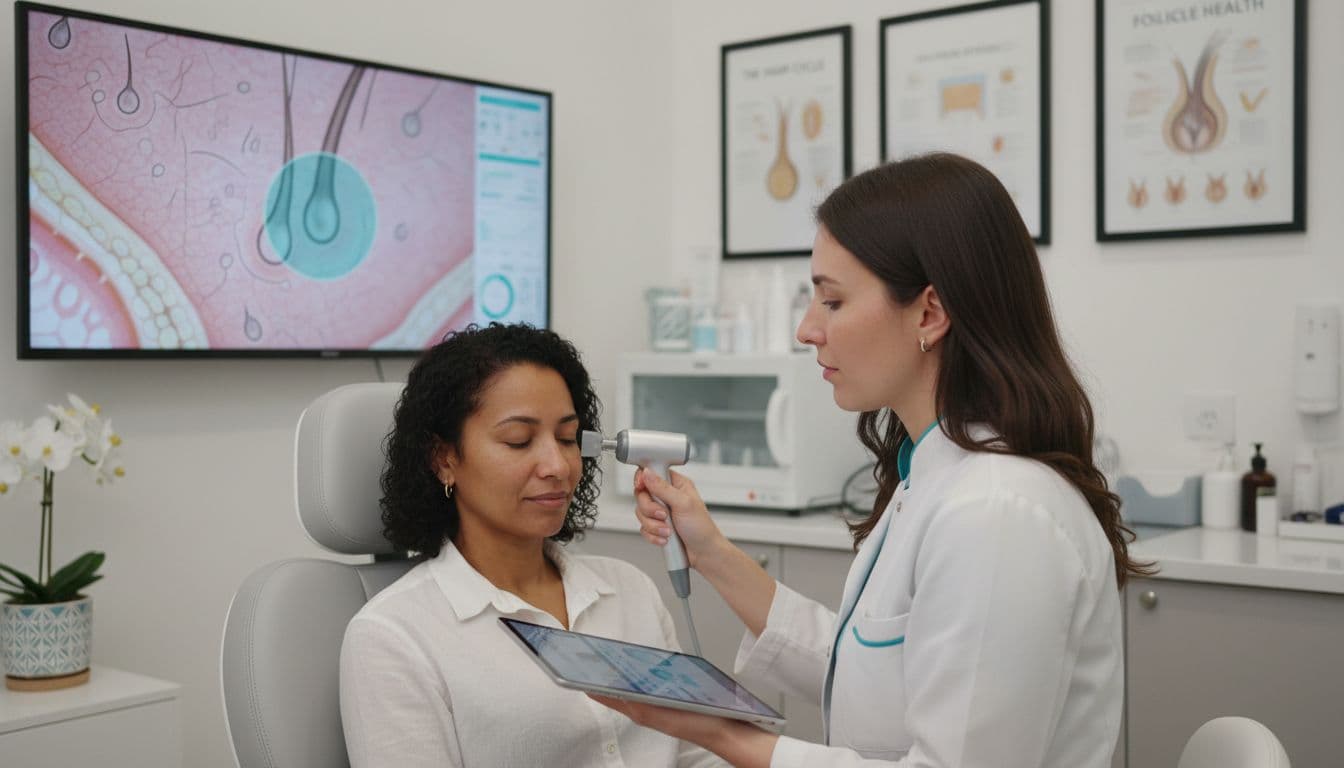Blog
Learning Materials
Improve Hair Health Naturally: Step-by-Step Guide for Results
Updated: November 23, 2025

Nearly half of american adults say hair concerns affect their confidence every day. The road to healthier hair is crowded with advice and endless product choices, making it easy to feel lost or frustrated. Reliable results come from a thoughtful approach that includes expert guidance and the latest smart tools. This guide breaks down each step so you can make informed decisions, starting with a clear assessment and moving toward routines and products that truly work for your unique needs.
Table of Contents
- Step 1: Assess Current Hair Health Using Smart Tools
- Step 2: Identify Key Factors Impacting Hair Condition
- Step 3: Implement Personalized Hair Care Routines
- Step 4: Select and Apply Targeted Hair Products
- Step 5: Track Progress and Adjust Strategies
Quick Summary
| Key Insight | Explanation |
|---|---|
| 1. Assess Hair Health Accurately | Use trichoscopy and digital tools to evaluate scalp and hair condition for tailored care. |
| 2. Understand Nutritional Impact | Evaluate your diet for essential nutrients to prevent hair loss and maintain growth. |
| 3. Personalize Your Hair Routine | Develop a hair care regimen based on your specific hair type and scalp needs. |
| 4. Select Quality Products | Choose hair products that contain vital nutrients and offer protection against environmental damage. |
| 5. Monitor Progress Regularly | Track your hair's health through documentation and assessments to adjust care strategies. |
Step 1: Assess Current Hair Health Using Smart Tools
Understanding your hair's current condition is the first critical step toward achieving healthier hair growth. By leveraging modern diagnostic techniques like trichoscopy, you can gain unprecedented insights into your scalp and hair follicle health.
According to Wikipedia, trichoscopy is a specialized diagnostic method that uses dermoscopy to evaluate hair and scalp conditions, providing detailed visualizations of hair structures at magnifications ranging from 10x to 70x. This technology allows you to see microscopic details about your hair that were previously invisible to the naked eye.
To effectively assess your hair health, consider using advanced digital tools that can analyze your hair's current state. These smart tools typically involve uploading clear photos of your scalp and hair, which are then processed using artificial intelligence algorithms. Look for platforms that offer comprehensive assessments including:
- Hair density measurements
- Follicle health analysis
- Scalp condition evaluation
- Potential growth patterns
Additionally, some advanced diagnostic approaches like Low-Level Laser Therapy can provide deeper insights into your hair's cellular health by stimulating mitochondrial activity and improving blood flow to hair follicles.
As you move forward, remember that accurate assessment is the foundation for developing a personalized hair care strategy. The more precise your understanding of your current hair health, the more targeted and effective your growth plan will be.
Step 2: Identify Key Factors Impacting Hair Condition
Understanding the complex web of factors that influence your hair health is crucial for developing an effective hair care strategy. Your hair's condition is not just about external treatments but a holistic interplay of multiple internal and external elements.
According to Hair Scientists, nutritional deficiencies can significantly impact hair structure and growth. Conditions like telogen effluvium and diffuse hair loss are directly linked to inadequate intake of essential nutrients. This means your diet plays a fundamental role in maintaining healthy hair. Key nutritional factors include protein intake, vitamin levels, and mineral balance.
Follicle Labs highlights that environmental factors also dramatically influence hair health. Elements like humidity, UV radiation, temperature variations, and pollution can adversely affect your hair and scalp. High humidity might cause frizz, while low humidity can lead to dryness. UV exposure can damage hair proteins, and air pollutants can irritate your scalp.
To comprehensively assess your hair's condition, consider evaluating these critical factors:
- Nutritional intake and potential deficiencies
- Stress levels and hormonal balance
- Environmental exposure
- Genetic predispositions
- Current hair care practices
By understanding these interconnected elements, you can develop a more nuanced and effective approach to improving your hair health.
 Each factor contributes uniquely to your hair's overall condition, and addressing them holistically is key to achieving optimal results.
Each factor contributes uniquely to your hair's overall condition, and addressing them holistically is key to achieving optimal results.

Step 3: Implement Personalized Hair Care Routines
Creating a hair care routine tailored to your unique hair needs is essential for achieving healthy, vibrant hair. This step transforms your understanding of hair health into actionable daily practices that support long-term hair wellness.
According to The Hair Society, maintaining a healthy scalp requires using gentle, pH-balanced shampoos that preserve the scalp microbiome. An imbalanced microbial ecosystem can trigger issues like dandruff, inflammation, and hair thinning. This underscores the importance of selecting products specifically designed for your hair type and scalp condition.
Merchant City Medical Group recommends adapting your hair care routine to seasonal changes. In summer, opt for lightweight, clarifying shampoos, while winter calls for heavier, more moisturizing products. Protective styling and consistent conditioning treatments can help minimize environmental damage throughout the year.
To develop your personalized routine, consider these key elements:
- Hair type assessment
- Scalp condition analysis
- Seasonal product adjustments
- Targeted treatment strategies
- Consistent care schedule
Remember that personalization is key. What works for someone else might not work for you. Be patient and willing to experiment until you find the perfect routine that makes your hair look and feel its best.
Step 4: Select and Apply Targeted Hair Products
Choosing the right hair products is a strategic process that goes beyond simple cosmetic preferences. Your selection can dramatically impact your hair's health, growth, and overall appearance.
Hair Scientists emphasize that incorporating products rich in essential nutrients like proteins, vitamins, and minerals can significantly support hair growth and structure. These targeted products can help address nutritional deficiencies and mitigate conditions such as telogen effluvium and diffuse alopecia.
Follicle Labs recommends selecting hair products that offer protection against environmental stressors. Look for products with UV filters to shield your hair from sun damage and formulations designed to combat pollution and prevent scalp irritation.
When selecting your hair products, focus on these critical criteria:
- Ingredient quality and nutrient profile
- Specific hair type compatibility
- Environmental protection features
- Scalp health considerations
- Individual hair growth goals
Remember that product selection is not a one-size-fits-all approach. What works for someone else might not work for you. Stay patient, be willing to experiment, and pay attention to how your hair responds to different products.
Step 5: Track Progress and Adjust Strategies
Monitoring your hair health journey is crucial for understanding what works and making informed adjustments to your care routine. This step transforms your hair care approach from guesswork to a data driven strategy.
Wikipedia highlights that trichoscopy provides a powerful method for tracking hair and scalp conditions over time. This diagnostic technique allows you to capture detailed images that can be systematically compared, helping you assess the effectiveness of your current treatments and hair care strategies.
The Hair Society recommends regular assessment of your hair health, including monitoring the scalp's microbial ecosystem and understanding environmental impacts. This proactive approach enables timely adjustments to your hair care routine, ensuring you can address potential issues before they become significant problems.
To effectively track your hair health progress, consider these strategic tracking methods:
- Monthly photo documentation
- Scalp and hair density measurements
- Performance tracking of hair care products
- Environmental condition logging
- Nutritional and lifestyle correlation analysis
Remember that progress is not always linear. Some strategies might show immediate results, while others require patience and consistent application. Stay observant, remain flexible, and trust the process of continuous improvement.
Unlock Your Best Hair Health with Personalized AI Insights
Struggling to make sense of your hair loss or unsure how to tailor your hair care routine effectively The article's step-by-step guide highlights the need for precise assessment and targeted strategies that truly understand your unique hair condition Your challenges like tracking hair changes over time and identifying key factors like scalp health or nutrition can feel overwhelming without clear direction

Take control today by tapping into the power of AI-based hair health analysis at MyHair.ai. Get personalized growth projections and tailored product recommendations that align perfectly with your hair goals Our platform lets you upload scans, monitor progress effortlessly, and adjust your regimen based on real data Don’t wait until problems worsen Start your journey toward healthier hair now by visiting MyHair.ai and discover how personalized care makes all the difference
Frequently Asked Questions
How can I assess my current hair health naturally?
To assess your hair health, consider using diagnostic tools like smartphone apps that analyze your hair type and scalp condition through user-uploaded photos. Capture clear images of your scalp and hair to start evaluating factors such as density and overall health.
What nutrients should I focus on for improving hair health?
Focus on a diet rich in protein, vitamins (especially biotin), and essential minerals like zinc and iron to support hair growth. Aim to incorporate a variety of these nutrients in your daily meals to see significant improvements within 30–60 days.
How often should I change my hair care routine?
You should reassess and potentially change your hair care routine with each season or when you notice changes in your hair's health. Monitor your hair's response to products and adjust your routine accordingly every 2–3 months to maintain optimal hair condition.
What are some effective natural products I can use for hair care?
Look for natural hair products that contain ingredients like coconut oil, aloe vera, or essential oils, which can nourish and protect your hair. Choose products based on your specific hair type and incorporate them into your routine to see improvements in health and appearance.
How can I track the progress of my hair health journey?
Track your hair health by documenting your journey with monthly photos of your scalp and hair, noting any changes. Use a simple journal or app to keep track of your product usage and environmental factors, adjusting your routine as needed based on your observations.
Should I consult a professional for my hair health issues?
If you notice persistent hair issues such as excessive thinning or scalp irritation, it may be beneficial to consult with a healthcare professional or a trichologist. Their insights can help you identify underlying health factors impacting your hair and guide you towards a more effective care plan.
Recommended
- Natural Products for Hair Growth and Thickness: A Complete Guide | MyHair
- Best Hair Mask for Hair Growth at Home: 2025 Guide | MyHair
- Achieve Sleek Hair with Natural Hair Straightening Treatment | MyHair
- Grow Hair Longer and Thicker: Your 2025 Guide | MyHair
- Building Healthy Habits Naturally: A Step-by-Step Guide – naturessoulshop
- What Is Holistic Haircare? Complete Essential Overview